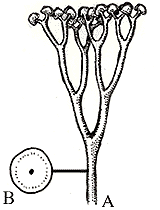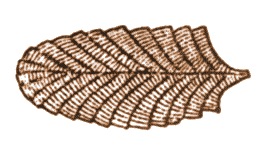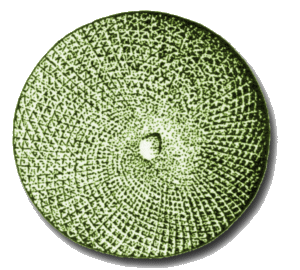

The Silurian was the third division of the Paleozoic era of the geologic time scale spanning from approximately 395 and 440 million years ago, preceded by the Ordovician and followed by the Devonian. Roderick Impey Murchison, a Scotsman, who eventually became the director of the Geological Survey of Great Britain, was responsible for naming the period. The term Silurian comes from Silures, the name of a celtic tribe of people that lived along the border of England and Wales before the time of the Romans. In the early 1800s, British geologists recognized rocks in this area that contained a distinctive assemblage of fossils, different from the fossils in both underlying strata of the Ordovician and overlying strata of the Devonian. Silurian fossils, identical to those in Britain, were subsequently discovered in many other regions of the world, including the Great Lakes region of North America.

Its stratigraphy is subdivided into four epochs: the Llandovery, the Wenlock, the Ludlow, and the Pridoli. Each epoch is distinguished from the others by the appearance of new species of graptolites.
The Llandovery (428-440 million years ago) preserves its fossils in shale, sandstone, and gray mudstone sediment. Its beginning is marked by the appearance of the graptolites Parakidograptus acuminatus and Akidograptus ascensus. The Llandoverian epoch is subdivided into the Rhuddanian, Aeronian, and Telychian stages.
The start of the Wenlockian epoch (428 - 421 million years ago) is marked by the appearance of Cyrtograptus centrifugus. The fossils are found in siltstone and mudstone under limestone. Missing from the fossil record of the Wenlock was the conodont Pterospathodus amorphognathoides, present in earlier strata. This is an epoch with excellent preservations of brachiopod, coral, trilobite, clam, bryozoan, and crinoid fossils. The Wenlock is subdivided into the Sheinwoodian and Homerian stages.
The Ludlow (421 - 414 million years ago) consists of siltstone and limestone strata, marked by the appearance of Neodiversograptus nilssoni. An abundance of shelly animal fossils is visable. The Gorstian and Ludfordian stages make up the Ludlow epoch.
The Pridolian, the final epoch of the Silurian, is recognized by platy limestone strata rich in cephalopods and bivalves. It is marked by the appearance of the index fossil Monograptus parultimus, and also by two new species of chitinozoans, Urnochitina urna,and Fungochitina kosovensis, which appear at the base or just above the base of the Pridoli.
The Silurian world was vastly different in many ways than the world of today. The shapes and distribution of the continents were drastically different from present day, and shallow seas covered much of the continental areas. For example, the equator passed through North America, and a nearly continuous inland sea stretched between New York and Nevada.
The Silurian is bracketed in time by two major mountain-building episodes: the Taconian orogeny of the preceding Ordovician period, and the Acadian orogeny of the following Devonian. Convergence of tectonic plates, which had begun during the Ordovician, crumpled the sedimentary rocks that had been accumulating in the Caledonian geosyncline of northwestern Europe.
Ordovician-Silurian extinction, about 439 million years ago, was a direct result of a drop in global temperature causing glaciers to form and sea levels to drastically plunge. The maximum global fall in sea level was as much as 170 meters resulting in the drainage of immense areas of former marine habitat. The consequential extinction was roughly 25 percent of marine families and 60 percent of marine genera. Among the hundred families which disappeared, the most concerned groups were Bryozoa, Brachiopods, solitary Corals, Trilobites, Graptolites, Echinoidea and Crinoids. Resumption of environmental conditions favorable to faunal recovery from the late Ordovician extinctions was the most significant geologic event of the Silurian Period. Basal Silurian strata reveals a rapid rise in the level of the sea, which reflooded vast continental platforms.
The end of the Silurian saw the forming of massive mountain ranges along the edges of the two continental margins, and in England a move to deposition of sediments derived from the new mountains - the Devonian system.

The Changing Earth During the Silurian and Important Implications for the Environment and Life within It
Note: In contrast to the Late Ordovician event, these fluctuations did not strongly affect the shelly bottom-dwelling invertebrates on continental platforms. Tropical reefs were common, formed by tabulate and rugose corals, stromatoporoid organisms, bryozoa, and calcareous algae. Reefs of all Silurian ages are known, but their development probably reached a climax during Wenlock time. Several thousand have been recognized from outcrop and subsurface evidence across a tract of 800,000 square km surrounding the Great Lakes region of North America. Trilobites, cephalopods, gastropods, echinoderms, and graptolites were common and diverse.


During the Silurian , the Earth witnessed many changes in the way in which landmasses were distributed around the globe. Although there were no major volcanic events, a thawing of glaciers and rise in sea levels produced varying periods of continent coverage and exposure. The variation of ocean levels occurred alongside the process of continental fragmentation and grouping that occurred from the Cambrian to the present.
The Silurian World
The period is marked by major orogenic events in eastern North America and in northwestern Europe forming mountain chains there. This was known as the Caledonian Orogeny. Large igneous rock formations of the Middle Silurian arose, such as those in Central Europe, as well as light sedimentation throughout the Baltic region.
Baltica and the attached microcontinent Avalonia begin colliding with North America. In the North Atlantic area the Silurian marked the closure of the great 'Iapetus' Ocean that separated North America from Northern Europe. At that time, even though the boundary of the Eastern edge of North America was more or less in the same position as today, Newfoundland and a portion of Eastmost America was on the South of the ocean together with England and Ireland. Northern Ireland and Scotland were on the Northern flank.

The Silurian is a time when many biologically significant events occurred. In the oceans, there was a widespread radiation of crinoids, a continued proliferation and expansion of the brachiopods, and the oldest known fossils of coral reefs. The Silurian was also a remarkable time in the evolution of fishes. Not only does this time period mark the wide and rapid spread of jawless fish, but also the highly significant appearances of both the first known freshwater fish as well as the appearance of jawed fish. Other marine fossils commonly found throughout the Silurian record include trilobites, graptolites, conodonts, corals, stromatoporoids, and mollusks. The first good evidence of life on land is also present, including relatives of spiders and centipedes, and also the earliest fossils of vascular plants. While it is possible that plants and animals first moved onto the land in the Ordovician, fossils of terrestrial life from that period are fragmentary and difficult to interpret. Silurian strata have provided likely ascomycete fossils, as well as remains of the first arachnids and centipedes.

Several small extinction and radiation events in the evolution of nektonic and pelagic organisms appear to be linked to Silurian fluctuations in sea level. Five graptolite radiations are recorded in the Silurian System. The Wenlock radiation, for example, involves distinct new genera such as Cyrtograptus and as many as 20 new species. Among conodonts, a significant radiation is indicated by species within the Pterospathodus amorphognathoides biozone, which straddles the LlandoveryWenlock boundary. Extinction of key species followed by the origination of several new species during the Wenlock epoch was one of the most drastic changes in the Silurian conodont succession.
Fish of the Freshwater and Marine Environments
Land Colonization and Adaptive Radiation of Vascular Plants
Problems on Land
Adaptive Solutions
With the introduction of these plants onto land, the terrestrial world began to alter. Plants help to break down rocks and contribute their own decaying remains to create rich, productive soils not available before this time. Plants also changed the pattern of erosion by binding soil with their roots and retaining runoff water.

Enigmatic plants: Still a Mystery
There were two mid Silurian graptolite extinctions and subsequent diversifications. This is believed to be due to slow recovery of grapolites after the Ordivician mass extinction.


Famous Silurian fossil sites include the Brownsport Group in Tennessee and Brandon Bridge, Wisconsin. Silurian creatures adopted as state fossils include New York's water scorpion Eurypterus remipes and Wisconsin's trilobite Calymene celebra. Silurian features of the United States include the following:
Other important fossil areas include: